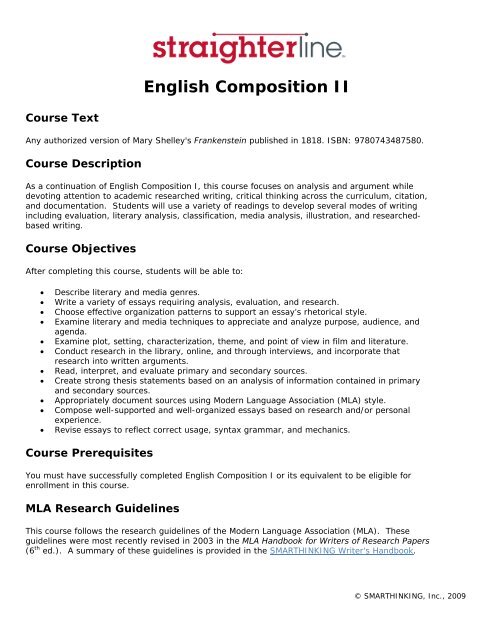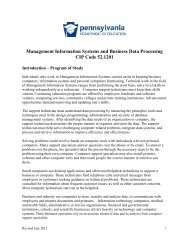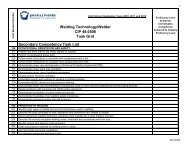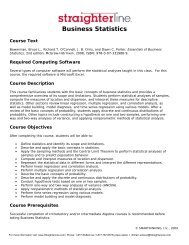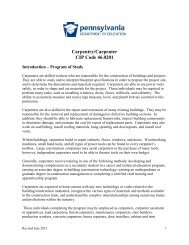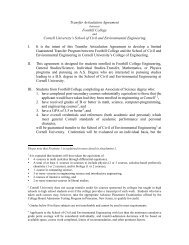English Composition II - CollegeTransfer.net
English Composition II - CollegeTransfer.net
English Composition II - CollegeTransfer.net
You also want an ePaper? Increase the reach of your titles
YUMPU automatically turns print PDFs into web optimized ePapers that Google loves.
<strong>English</strong> <strong>Composition</strong> <strong>II</strong><br />
Course Text<br />
Any authorized version of Mary Shelley's Frankenstein published in 1818. ISBN: 9780743487580.<br />
Course Description<br />
As a continuation of <strong>English</strong> <strong>Composition</strong> I, this course focuses on analysis and argument while<br />
devoting attention to academic researched writing, critical thinking across the curriculum, citation,<br />
and documentation. Students will use a variety of readings to develop several modes of writing<br />
including evaluation, literary analysis, classification, media analysis, illustration, and researchedbased<br />
writing.<br />
Course Objectives<br />
After completing this course, students will be able to:<br />
• Describe literary and media genres.<br />
• Write a variety of essays requiring analysis, evaluation, and research.<br />
• Choose effective organization patterns to support an essay’s rhetorical style.<br />
• Examine literary and media techniques to appreciate and analyze purpose, audience, and<br />
agenda.<br />
• Examine plot, setting, characterization, theme, and point of view in film and literature.<br />
• Conduct research in the library, online, and through interviews, and incorporate that<br />
research into written arguments.<br />
• Read, interpret, and evaluate primary and secondary sources.<br />
• Create strong thesis statements based on an analysis of information contained in primary<br />
and secondary sources.<br />
• Appropriately document sources using Modern Language Association (MLA) style.<br />
• Compose well-supported and well-organized essays based on research and/or personal<br />
experience.<br />
• Revise essays to reflect correct usage, syntax grammar, and mechanics.<br />
Course Prerequisites<br />
You must have successfully completed <strong>English</strong> <strong>Composition</strong> I or its equivalent to be eligible for<br />
enrollment in this course.<br />
MLA Research Guidelines<br />
This course follows the research guidelines of the Modern Language Association (MLA). These<br />
guidelines were most recently revised in 2003 in the MLA Handbook for Writers of Research Papers<br />
(6 th ed.). A summary of these guidelines is provided in the SMARTHINKING Writer's Handbook.<br />
© SMARTHINKING, Inc., 2009
Academic Honesty<br />
Academic honesty is expected of all students.<br />
To reflect academic honesty, students must:<br />
• Submit only their own work.<br />
• Use quotations and citations to indicate words taken from another source.<br />
• Cite instances of paraphrasing (rewording) information.<br />
• Cite ideas or examples that are not general knowledge.<br />
Important Terms<br />
In this course, different terms are used to designate tasks:<br />
• Assignment: A written piece that will be submitted to SMARTHINKING for a grade when the<br />
final draft is complete.<br />
• Practice Exercise: A non-graded quiz or writing piece that provides practice using skills<br />
discussed in a topic.<br />
• Graded Quiz: A graded online assessment.<br />
• Graded Exam: A graded online assessment.<br />
Writing Submissions<br />
Writing exercises and assignments may only be submitted as .doc, .docx, .rtf, or .txt files.<br />
Macintosh users should add an extension (.doc or .rtf) to the file name before uploading. If you<br />
have questions on saving files, please contact support@smarthinking.com.<br />
Course Evaluation Criteria<br />
StraighterLine does not apply letter grades. Students earn a score as a percentage of 100%. A<br />
passing percentage is 70% or higher. If you have chosen a Partner College to award credit for this<br />
course, your final grade will be based upon that college's grading scale. Only passing scores will be<br />
considered by Partner Colleges for an award of credit.<br />
There are a total of 393 points in the course:<br />
Topic Assessment Points<br />
Available<br />
A1<br />
1<br />
Graded Quiz A-1: Plagiarism<br />
Graded Quiz 1.1: Reading Literature<br />
10<br />
10<br />
1 Graded Quiz 1.2: Frankenstein 5<br />
2 Graded Quiz 2.1: Symbolism, Allegory, and Irony 10<br />
2 Graded Quiz 2.2: Frankenstein 5<br />
2 Writing Assignment: Cartoon Analysis 21<br />
3 Graded Quiz 3.1: Frankenstein 5<br />
4 Graded Quiz 4.1: Evaluation 10<br />
4 Graded Quiz 4.2: Frankenstein 5<br />
4 Comprehensive Graded Exam: Frankenstein 100<br />
4 Writing Assignment: Frankenstein Evaluation Essay 21<br />
5 Graded Quiz 5.1: Thesis Development 6<br />
5 Graded Quiz 5.2: Revising and Editing 10<br />
5 Writing Assignment: Frankenstein Application Essay 21<br />
6 Graded Quiz 6.1: Interviewing 10<br />
© SMARTHINKING, Inc., 2009
7 Graded Quiz 7.1: Argument Letter 10<br />
7 Graded Quiz: 7.2: Research and Citation 20<br />
7 Writing Assignment: Researched Proposal Letter 21<br />
8 Graded Quiz 8.1: Media Analysis 10<br />
8 Writing Assignment: Media Analysis Essay 21<br />
9 Graded Quiz 9.1: Illustration 10<br />
9 Writing Assignment: Illustration Essay 21<br />
10 Graded Quiz 10.1: Classification 10<br />
10 Writing Assignment: Classification Essay 21<br />
Course Topics and Objectives<br />
Topic Lesson Topic Subtopics Objectives<br />
1 Reading Literature • Genres of Literature<br />
• Close Reading<br />
• Elements of Close<br />
Reading Specific to<br />
Genre<br />
2 Language Use • Symbolism<br />
• Irony<br />
• Allegory<br />
• Imagery<br />
• Simile<br />
• Metaphor<br />
• Define a “close reading” of a text.<br />
• Classify a piece of literature as<br />
fiction, poetry, drama, or nonfiction.<br />
• Compare and contrast different ways<br />
of reading the four basic types of<br />
literature.<br />
• Interpret symbols, irony, and<br />
allegory.<br />
• Identify imagery and describe its<br />
effect.<br />
• Identify and explain simile and<br />
metaphor in literary works.<br />
• Examine literary elements in a comic<br />
or political cartoon analysis.<br />
3 Examining Fiction • Fiction Writers in<br />
Context<br />
• Examining Stories<br />
that Share a Common<br />
Theme<br />
• Critical Thinking: How<br />
Themes Help Us<br />
Connect with Works<br />
of Fiction<br />
4 Evaluation • Introduction to<br />
Evaluation<br />
• Evaluation Strategies<br />
• Writing an Evaluation<br />
Essay<br />
5 Writing about Literature • Inventing a Thesis<br />
• Defining Your<br />
Audience<br />
• Writing and Revising:<br />
Supporting Your<br />
Thesis<br />
• Editing and<br />
Proofreading: Giving<br />
a Paper the Final<br />
Touch<br />
• Examine ways in which knowing an<br />
author's context helps you better<br />
understand a story.<br />
• Evaluate different authors'<br />
treatments of the same theme.<br />
• Describe how having your own life<br />
experience with a particular theme<br />
lets you read fiction more critically.<br />
• Examine an author’s language, style,<br />
evidence, and purpose to evaluate a<br />
written piece.<br />
• Develop an informed opinion, and<br />
present it in a written essay.<br />
• Recognize logical flaws and avoid<br />
them in writing.<br />
• Describe several strategies available<br />
for creating a thesis.<br />
• Purposefully choose a paper’s<br />
audience.<br />
• Write a well-organized paper that<br />
strongly supports its thesis.<br />
• Write well-organized paragraphs that<br />
strongly support their topic<br />
sentences.<br />
• Identify and correct awkward<br />
sentences and punctuation errors.<br />
• Write an well-organized essay,<br />
applying the themes of Mary<br />
Shelley’s Frankenstein to modern<br />
day life.<br />
© SMARTHINKING, Inc., 2009
6 The Interview • Introduction to<br />
Interviewing<br />
• Interviewing<br />
Strategies<br />
• Using Interview Data<br />
in Research<br />
• Prepare for a successful research<br />
interview.<br />
• Complete a professional interview to<br />
elicit the necessary information.<br />
• Incorporate researched information<br />
from the interview into a written<br />
piece.<br />
7 Research • Argument: Defending<br />
a Position or Opinion<br />
Through Research<br />
• Sources for Research<br />
• Accurately Citing Your<br />
Sources<br />
8 Media Analysis • Introduction to<br />
Analyzing Broadcast<br />
Media and Film<br />
• Television and Film<br />
Analysis Strategies<br />
• Writing a Film<br />
Analysis Essay<br />
9 Illustration • Introduction to<br />
Illustration<br />
• Illustration Strategies<br />
• Writing an Illustration<br />
Essay<br />
10 Classification • Introduction to<br />
Classification<br />
• Classification<br />
Strategies<br />
• Classification and<br />
Analysis<br />
• Writing an<br />
Classification Essay<br />
11 Review • Reading Literature<br />
• Language Use<br />
• Examining Fiction<br />
• Evaluation<br />
• Writing about<br />
Literature<br />
• The Interview<br />
• Research<br />
• Media Analysis<br />
• Illustration<br />
• Classification<br />
• Define the purpose of a researched<br />
proposal letter.<br />
• Formulate a substantial argument<br />
for a researched proposal letter.<br />
• Locate and evaluate sources to<br />
support a research topic.<br />
• Employ accurate MLA citing.<br />
• Analyze a media production by<br />
focusing on a specific creative<br />
element.<br />
• Use correct terminology to refer to<br />
elements of a media production.<br />
• Synthesize observations from the<br />
film or television production and<br />
craft a media analysis essay.<br />
• Create a thesis statement for an<br />
illustration essay.<br />
• Provide illustrations for a claim.<br />
• Select appropriate examples to<br />
support a claim.<br />
• Use logical explanation to indicate<br />
how the examples illustrate your<br />
point.<br />
• Create a purposeful thesis statement<br />
for a classification essay.<br />
• Classify like items or ideas based on<br />
their traits.<br />
• Analyze a larger category and divide<br />
a larger category into subgroups<br />
that include all examples from that<br />
category.<br />
• Define the subgroups, indicating the<br />
traits all members must share.<br />
• Select representative examples and<br />
non-examples of items in that group,<br />
explaining why they do or do not fit.<br />
• None<br />
© SMARTHINKING, Inc., 2009


